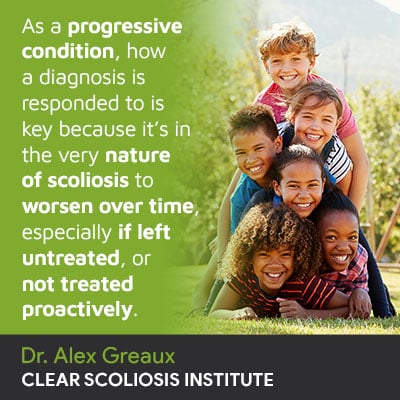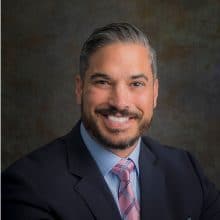![What Kind Of Doctor Treats Scoliosis? [EXPLORED] Image](https://clear-institute.org/wp-content/uploads/2022/11/what-kind-of-doctor-treats-scoliosis.jpg)
While most cases of scoliosis can be treated non-surgically, patients who find themselves on the path of traditional treatment are often funneled towards spinal fusion surgery; CLEAR-certified chiropractors can give patients an effective non-surgical treatment option. Finding a doctor who specializes in scoliosis and is trained/certified in multiple treatment modalities increases the chances of treatment success.
After a scoliosis diagnosis, the most important decision to make is how to treat it moving forward; different treatment approaches offer patients different potential outcomes. Many general doctors treat patients with scoliosis, but only a specialist can effectively treat the scoliosis itself.
Let’s start our discussion of scoliosis doctors by exploring the two main scoliosis treatment approaches, traditional and conservative.
If a person is diagnosed with scoliosis, they have an important decision to make because the chosen treatment approach can have life-long effects.
Scoliosis is the development of an unnatural sideways spinal curve, with rotation, and a minimum Cobb angle measurement of 10 degrees.

The spine is a complex structure, and its natural curvatures keep it strong, flexible, and able to absorb stress, like a coiled spring; if the spine loses one or more of its healthy curves, its biomechanics are disrupted and can affect its overall health and function.
To summarize, scoliosis is a complex condition to treat for the following reasons:
Because scoliosis is progressive, where it is at the time of diagnosis is not indicative of where it will stay, which is why the best time to start treatment is always now.
A patient diagnosed with mild scoliosis can easily progress to moderate or severe, hence the benefit of proactive treatment applied as early as possible to stay ahead of a condition’s progressive line.
As mentioned, the majority of scoliosis cases can be treated non-surgically, but those on the path of traditional scoliosis treatment often find themselves funneled towards spinal fusion, and this is because of its reactive response to mild scoliosis.
A traditional scoliosis treatment provider would likely say that if an adolescent’s scoliosis is mild, the response should be watching and waiting for further progression; this is because traditional treatment doesn’t actually have a strategy for addressing scoliosis while mild.
The only form of treatment applied, and not until progression into the moderate or severe level has occurred, is traditional bracing, which is associated with a number of shortfalls.
If bracing is unsuccessful at stopping progression, a patient becomes a surgical candidate after crossing the surgical-level threshold at 40+ degrees, hence the waiting until a condition progresses to that point.
In the meantime, however, proactive efforts could have been made to counteract a condition’s progressive nature and prevent patients from progressing to the point of becoming a surgical candidate.
Spinal fusion is an invasive and costly procedure, and like all surgical procedures, comes with its share of potential risks and side effects; for those who choose to forego a surgical recommendation or want to try a different form of treatment first, conservative treatment offers patients a non-surgical alternative, with proven results.
Also known as functional and/or chiropractic-centered, a conservative treatment approach responds to a scoliosis diagnosis proactively, by starting treatment as soon as possible.
I see watching and waiting as wasting valuable treatment time because as a progressive condition, we know that virtually every case of scoliosis is going to progress at some point, so why not be proactive and work towards preventing progression and the hardships associated with it: increasing condition severity, escalating symptoms, and the need for more invasive treatment in the future.
In addition, while there are no treatment guarantees, early detection does increase chances of treatment success, but only if it’s met with proactive treatment; scoliosis is less complex to treat while mild, before spinal rigidity has increased, and before the body has had ample time to adjust to its presence.
Conservative treatment values what different treatment disciplines can bring to the table, and the complex nature of scoliosis necessitates the customization of effective treatment plans.
By combining condition-specific treatment disciplines such as chiropractic care, a variety of therapies, custom-prescribed home exercises, and corrective bracing, curvatures can be reduced, and core strength can be increased so the spine is optimally supported and stabilized, and this is how the CLEAR Scoliosis Institute approaches treatment.
So now that we’ve explored the different types of scoliosis treatment, let’s move on to the topic of what kind of doctor treats scoliosis.

Choosing the right scoliosis doctor sometimes requires a patient to advocate for themselves, or for a loved one, to ensure they are aware of all treatment options available and that they understand the distinction between treating someone with scoliosis, versus treating the scoliosis itself.
A general practitioner can certainly detect a scoliosis, and in those cases, the path of treatment generally follows a referral from the family doctor to an orthopedic surgeon: the traditional surgical route.
If a patient commits to treatment from their GP, this is most likely going to involve treating the patient’s symptoms, more so than addressing their underlying cause; this can involve pain management, when needed, monitoring for progression with X-rays, and the prescription of scoliosis-friendly exercises and stretches, but this is not the same as working towards sustainable corrective results.
Scoliosis is incurable, but it is highly treatable; however, as a structural spinal condition, effective treatment has to, first and foremost, impact the condition on a structural level.
As a CLEAR-certified scoliosis chiropractor, I know the spine, and I know scoliosis, and while family doctors have their patients’ best interests at heart, the experience/training needed to correct a condition as complex as scoliosis is beyond the scope of general treatment, requiring specialized advanced training.
The CLEAR approach to treatment involves an intense course of treatment, either standard care involving approximately 3 clinic visits a week that taper off based on results, to intensive care (twice daily for two weeks).
These treatment plans also involve a daily home-rehabilitation program that will be customized to suit each patient and their condition so their spine can continue to heal and stabilize.
An average treatment session lasts around two hours and will involve a series of chiropractic adjustments and techniques to impact the condition on a structural level, and a variety of exercises and therapies to complement those corrective results.
Once I start to see structural results, I help patients work towards increasing core strength so the spine is optimally supported by its surrounding muscles, and scoliosis-specific exercises (SSEs) are also known to activate certain areas of the brain for enhanced brain-body communication, postural remodeling, and a more natural body positioning.
Remember, when it comes to finding the right scoliosis doctor, even a specialist might only be trained and experienced in one form of treatment, but I firmly believe that scoliosis patients benefit the most from treatment provided by a specialist capable of combining multiple condition-specific therapies for the best, and most specific, results.
Never be afraid to inquire as to the types of certifications and treatment modalities a potential scoliosis treatment provider has. Following are some of the most respected and successful certification options to look for in a scoliosis specialist:
Living with a complex spinal condition can pose its challenges, but scoliosis patients can benefit from treatment provided by a specialist capable of combining multiple therapies and treatment modalities so improvements can be made.
People with scoliosis will have it for life, but through proactive treatment and rehabilitation, its effects can be minimized, and people can thrive with the condition.
When it comes to finding the right scoliosis treatment provider, in addition to ensuring their treatment approach can deliver the outcome patients are looking for, ensuring the treatment provider is certified in multiple distinct treatment modalities means there are fewer limits to what they can achieve.
As a CLEAR-certified scoliosis chiropractor, I can combine multiple types of treatment, for a truly customized approach, that strives to preserve as much of the spine’s natural function as possible, while preventing the need for invasive surgery in the future.

CLEAR provides a unique and innovative way of understanding scoliosis. Sign up to receive facts and information you won’t find anywhere else.
